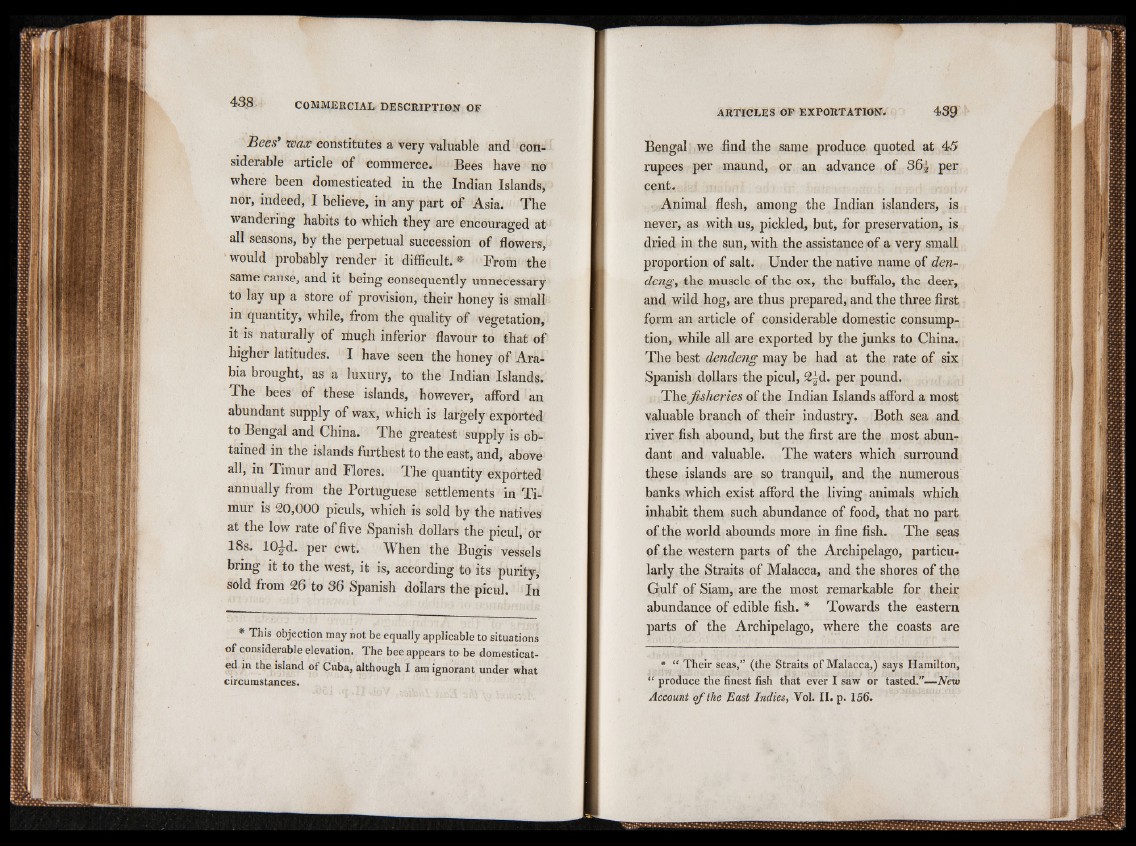
Bees* wax constitutes a very valuable and considerable
article of commerce. Bees have no
where been domesticated in the Indian Islands,
nor, indeed, I believe, in any part of Asia. The
wandering habits to which they are encouraged at
all seasons, by the perpetual succession of flowers,
would probably render it difficult. * From the
same cause, and it being consequently unnecessary
to lay up a store of provision, their honey is small
in quantity, while, from the quality of vegetation,
it is naturally of riiuph inferior flavour to that of
higher latitudes. I have seen the honey of Arabia
brought, as a luxury, to the Indian Islands.
The bees of these islands, however, afford an
abundant supply of wax, which is largely exported
to Bengal and China. The greatest supply is obtained
in the islands furthest to the east, and, above
all, in Timur and Flores. The quantity exported
annually from the Portuguese settlements in Timur
is 20,000 piculs, which is sold by the natives
at the low rate of five Spanish dollars the picul, or
18s. 10^-d. per cwt. When the Bugis vessels
bring it to the west, it is, according to its purity,
sold from 26 to 36 Spanish dollars the picul. In
* This objection may not be equally applicable to situations
of considerable elevation. The bee appears to be domesticated
in the island of Cuba, although I am ignorant under what
circumstances.
Bengal we find the same produce quoted at 4.5
rupees per maund, or an advance of 36| per
cent.
Animal flesh, among the Indian islanders, is
never, as with us, pickled, but, for preservation, is
dried in the sun, with the assistance of a very small
proportion of salt. Under the native name of den-
deng, the muscle of the ox, the buffalo, the deer,
and wild hog, are thus prepared, and the three first
form an article of considerable domestic consumption,
while all are exported by the junks to China.
The best dendeng may be had at the rate of six
Spanish dollars the picul, 2|d. per pound.
The fisheries of the Indian Islands afford a most
valuable branch of their industry. Both sea and
river fish abound, but the first are the most abundant
and valuable. The waters which surround
these islands are so tranquil, and the numerous
banks which exist afford the living animals which
inhabit them such abundance of food, that no part
of the world abounds more in fine fish. The seas
of the western parts of the Archipelago, particularly
the Straits of Malacca, and the shores of the
Gulf of Siam, are the most remarkable for their
abundance of edible fish. * Towards the eastern
parts of the Archipelago, where the coasts are
* “ Their seas,” (the Straits of Malacca,) says Hamilton,
“ produce the finest fish that ever I saw or tasted.”— New
Account o f the East Indies, Vol. II. p. 156.